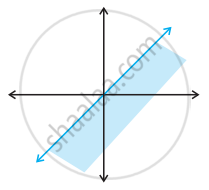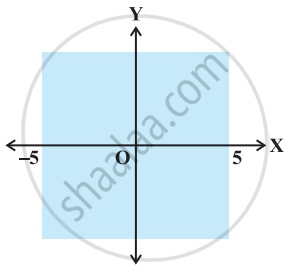Advertisements
Advertisements
Question
Find all pairs of consecutive even positive integers, both of which are larger than 5 such that their sum is less than 23.
Solution
Let x be the smaller of the two consecutive even positive integers. Then, the other integer is x + 2.
Since both the integers are larger than 5,
x > 5 ... (1)
Also, the sum of the two integers is less than 23.
x + (x + 2) < 23
⇒ 2x + 2 < 23
⇒ 2x < 23 – 2
⇒ 2x < 21
⇒ x < `21/2`
⇒ x < 10.5 ...(2)
From (1) and (2), we obtain 5 < x < 10.5.
Since x is an even number, x can take the values 6, 8, and 10.
Thus, the required possible pairs are (6, 8), (8, 10), and (10, 12).
APPEARS IN
RELATED QUESTIONS
Solve 24x < 100, when x is an integer.
Solve –12x > 30, when x is a natural number.
Solve –12x > 30, when x is an integer.
Solve 5x – 3 < 7, when x is an integer.
Solve 3x + 8 > 2, when x is a real number.
Solve the given inequality for real x: 3x – 7 > 5x – 1.
Solve the given inequality for real x: 3(x – 1) ≤ 2 (x – 3)
Solve the given inequality for real x: x + `x/2` + `x/3` < 11
Solve the given inequality for real x : `(3(x-2))/5 <= (5(2-x))/3`
Solve the given inequality for real x: `x/4 < (5x - 2)/3 - (7x - 3)/5`
Solve the given inequality and show the graph of the solution on number line:
3(1 – x) < 2 (x + 4)
Find all pairs of consecutive odd positive integers both of which are smaller than 10 such that their sum is more than 11.
A man wants to cut three lengths from a single piece of board of length 91 cm. The second length is to be 3 cm longer than the shortest and the third length is to be twice as long as the shortest. What are the possible lengths of the shortest board if the third piece is to be at least 5 cm longer than the second?
[Hint: If x is the length of the shortest board, then x, (x + 3) and 2x are the lengths of the second and third piece, respectively. Thus, x = (x + 3) + 2x ≤ 91 and 2x ≥ (x + 3) + 5]
Solve the inequality.
`-3 <= 4 - (7x)/2 <= 18`
Solve the inequality.
`-15 < (3(x - 2))/5 <= 0`
Solve the inequality.
`-12 < 4 - (3x)/(-5) <= 2`
Represent to solution set of each of the following inequations graphically in two dimensional plane:
x + 2 ≥ 0
Represent to solution set of each of the following inequations graphically in two dimensional plane:
4. x − 2y < 0
Represent to solution set of each of the following inequations graphically in two dimensional plane:
0 ≤ 2x − 5y + 10
Represent to solution set of each of the following inequations graphically in two dimensional plane:
3y ≥ 6 − 2x
Solutions of the inequalities comprising a system in variable x are represented on number lines as given below, then ______.![]()
State whether the following statement is True or False.
If x > y and b < 0, then bx < by
State whether the following statement is True or False.
If xy < 0, then x > 0, and y > 0
State whether the following statement is True or False.
If |x| < 5, then x ∈ (–5, 5)
State whether the following statement is True or False.
Solution set of x – y ≤ 0 is

The inequality representing the following graph is ______.
Solution of a linear inequality in variable x is represented on number line given below ______.
If x > –2 and x < 9, then x ∈ (– 2, 9)
If |x| > 5, then x ∈ (– `oo`, – 5) ∪ [5, `oo`)
